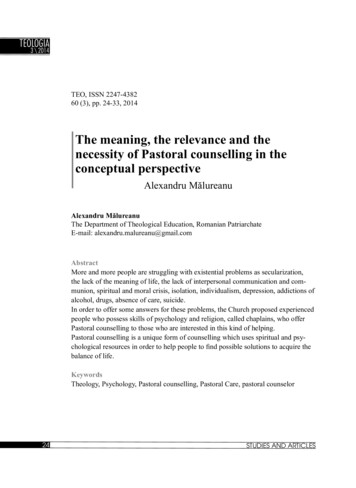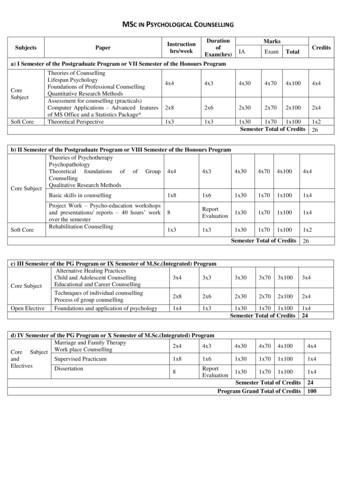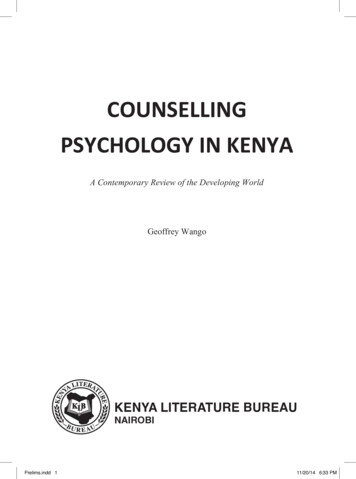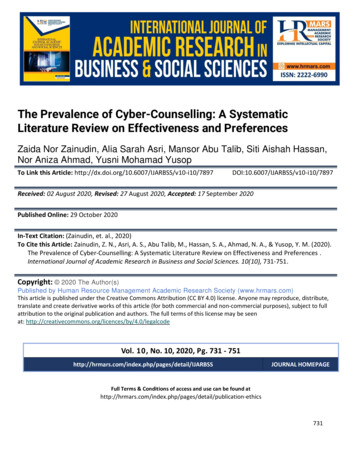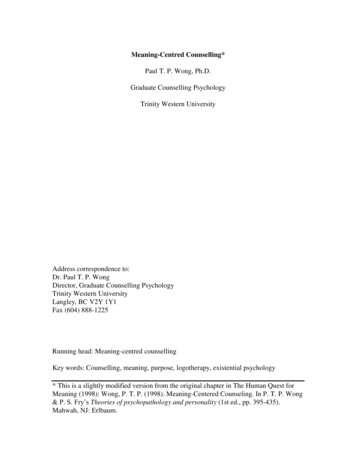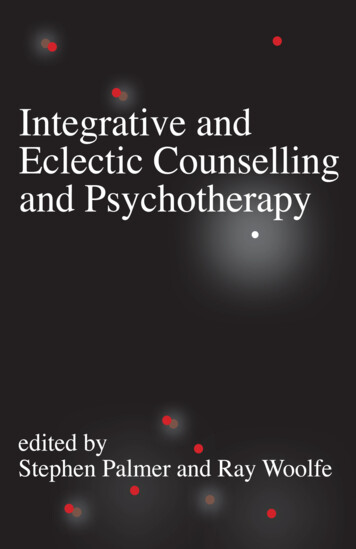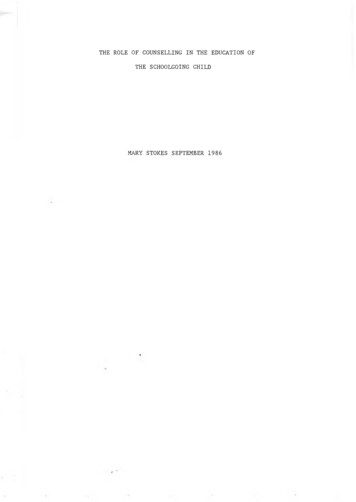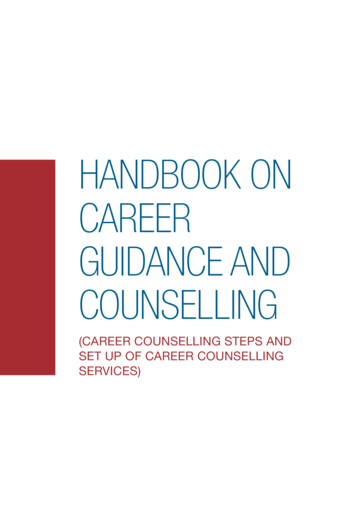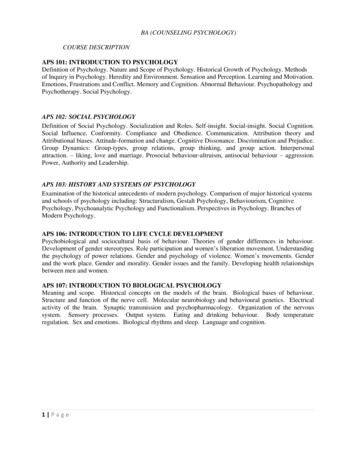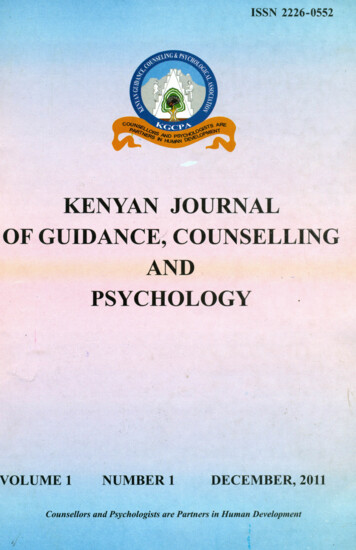
Transcription
ISSN 2226-0552KENYAN JOURNALOF GUIDANCE, COUNSELLINGANDPSYCHOLOGYVOLUME 1NUMBER 1DECEMBER, 2011Counsellors and Psychologists are Partners in Human Development"
ISSN 2226-0552KENYAN YAN UMBER1DECEMBER,2011
Factors affecting Career Certainty among University StudentsL. Maingi and Christine M. WasangaKenyatta UniversityAbstractWhile the career development process is life-long. choices made during the college yearsare particularlysignificant in selling the foundation for future professionaloptions.Selecting a career can be a daunting task/or man)' University students who must balancetheir 0\1"/1 interests with what is available in the various Universities as with their academicperformance. It is in this view that the researcher aimed at investigating the career certaintyof the university students. Stratified sampling \Vas used lO enhance representation 0/ thestudent populationwhile the academic advisors were randomly sampled.The main researchinstruments utilized in the study were questionnaires and interviews. The data gatheredliDSboth qualitative and quantitative. Qualitative II'US thematically presented in narrativeform while ed the use offrequencies.techniquestotals, percentages,by Pearson :s' product-momentcarried out to analyze the degree ofrelationshipscorrelationbetween the variablesand(I) werewhile Chi-squareand analysis 0/ variance were done to determine the significant differences between thevariables. There were many factors that affect the students' career choices amidst thembeing their level of occupational information, their decision- making ability and their levelofclarityin their personalall the levels 0/ educationattributesand resources.The need/orwas highly revealed by the findingsKey words: Career certainty,Decision-makingabi Iitycareer counseling0/ thisCareer decision profile. ntroductionGiving young people the tools and knowledge to realistically plan for their futures is aprimary goal of education globally. Career development is vitally important for today'syouth. who are more than ever "motivated but di rectionless" (Schneider & Stevenson,1999). While the career development process is life-long. choices made during the collegeyears are particularly significant in setting the foundation for future professional options.During the college experience, academic and career choices are complex as they integratetwo major considerations:individual development along with ongoing self-discovery andthe current and future work environment. Better understanding of the career developmentprocess can enhance linkage of academic and career experiences and improve careerpreparation and management. (Northwestern University Career Services, 2007).The Education and Skills White Paper (2005) by the Department for Education and Skills(DFES) in the government of UK outlined the need for young people to make their owncareer choices and set out the subsequent need for the provision of quality, impartial adviceto ensure young people make well-informed choices. The Paper also stated that young peopleneed the skills to make sound career decisions. The (2006) Implementation Plan by the samedepartment (DFES) followed and emphasized the necessity of schools. colleges and trainingproviders working together to provide appropriate support to young people. In a briefingpaper published in March 2004. the National Institute for Careers Education and Counseling(NICEC) identified a need for careers specialists to work with senior management to setpolicy and resource priorities for careers education and guidance, to support those involvedin its delivery, to constantly review the provision of careers education, and to develop and81
evaluate careers work.Blenkinsop, McCrone, Wade and Morris (2006) report noted some incidences of studentsstruggling to cope when faced with unanticipated changes indicating that most universitystudents are poorly prepared for major life decisions such as career choice. The first year ofcollege is crucial to college success where student retention and career indecision are importantfactors. The report on the Kenyan public universities Vice Chancellors committee on causesof disturbances/riots in public universities (2000) stated that University Academic Advisoryservices are scantily offered due to; large numbers of students; lack of office space for mostlecturers who also leave campuses soon after delivering their lectures and unavailability ofthe Dean of students and head of departments who by nature of their positions are not easilyavailable. The committee however noted that lack of academic advisory services was one ofthe major problems particularly for the first year students who spent a lot of time decidingwhich programmes and courses to pursue.According to the study by Mwangi (1991) at Kenyatta University on students' problems,students rated academic/careerissues as their most prevalent problems. Karihe (2006) foundthat Jomo Kenyatta University of Agriculture and Technology students rated academicproblems highly amongst other problems. Some of such academic problems includedirrational course selection procedures, low academic grades and poor relationships with theirlecturers all which point to the need for academic and career guidance and counselling.Perrone (2002 P. 1) quotes;"The College years are a crucial time for career-related decision-making.College studentsare faced with the need to choose an academic major as well as to develop career goals forthe future. Career indecision is often thought of as a developmentalphase through whichcollege students pass on the road to making a career choice and is negatively related toadjustment and well-being for college students."People typically make their first career related decisions during adolescence. Such decisionsmay have lifelong consequences for the individual's vocational future, psychological wellbeing, health, and social acceptance (Mann, Harmoni, & Power, 1989). With the KenyanUniversity student belonging to the category between late adolescence and early adulthoodaccording to the Kenyan public universities Vice-Chancellors'committee report (2000),assistance by professional career specialists is necessary, This stage of life is characterizedby periods of instability, conflict, anxiety and tension. Some of its manifestations includeidealism, experimentation,risk taking, emotional instability and inner turmoil. All theseaffect rational decision-making.Like the times of Industrialization when vocational guidance was birthed, a lot of changeshave occurred in the labour market today. More than any other single factor, technology andeconomic competition have had mutually accelerating effects (UNESCO, 1996).Echoing the same, the report by the vice-chancellors committee on causes of disturbances/riots in public universities (2000) states that; the advent of technology and the mediarevolution has had long-term significant effects on University Education. Competition hascreated opportunities for some, and hardships for others. The committee says, for betterfor worse, technology is one of the primary causes of the growing polarization of the workforce, of increasingly glaring inequities. Though there have been technological shifts thathave impacted to the labour market greatly, Education programmes may not have reflected82
this change. Some University programmes have become more marketable while others havelost market due \0 these changes. This has complicated career decision-making.Faced bythe fear of unemployment, students joining the University are confronted with the challengeof flocking in the most marketable programmes at the expense of their own best-placedoccupations.According to the Education symposium on re-engineering University Education for Nationaldevelopment (2003). Universities were challenged to develop curricula that are sensitive totechnological developments and the need of the industry and society. The Universities werealso challenged to inculcate the idea that one was not being educated for a job but for lifeand to be able to survive in an increasingly competitive and sometimes hostile environment.Such an understanding would only be reached if students were equipped with both up todate labour market information as well as individual personal awareness both of whichare basic for mature career decision-making.In secondary schools where career guidancehave been emphasized over time, teachers have heavy teaching workloads and so manystudents to attend to especially with the introduction of free primary education in Kenya.Kinyanjui (1990) recommended proper guidance and counselling services should be offeredto students in secondary schools from as early as when they join form one. She suggestedthat such services would help students to adjust their career aspirations to the realities andprevent future frustrations. In his research on career aspirations of form four students insome Kenyan schools. Mwangi (2002) noted that majority of the students (64.9%) appearednot to have specific orientation to careers. Most of these students (50%) intended to join theuniversity though. This implies that most students at University entry have no specific careeraspirations.Adolescent occupational choice is influenced by many factors. including life context, personalaptitudes. and educational attainment. Whether college-bound or work-bound, meeting thechallenge of this developmental milestone is critical in adolescents' lives (F erry, 2006). Thecareer choice that young adults make is embedded in their perceptions of the "ideal job" andtheir career decision-makingmaturity. Tn a 1996 NTCEC briefing paper, it was repOlied thatyoung people's career decisions are influenced by a range of factors and issues, includingparents and other relatives, friends and peer-groups, careers specialists, subject teachers,contacts with employers and direct experiences of employment, and individual interests andvalues. Blenkinsop et a1. (2006), in addition, identified perceptions of a subject and financialissues as influencing factors. This indicates the dire need for assistance through this processfor most young people.With the 8-4-4 System chances of pursuing courses of personal interest are limited due tothe stiff competition for the fev: vacancies in the Universities. Besides, those joining theuniversities are younger and less specialized than in the previous 7-4-2-3 Education systemin Kenya. Academic/careerissues have therefore increased and become more complexunlike in the days when Mwangi (1991) carried out his study. There is a mismatch betweenthe job market needs and the university admission process where in spite of decline in thedemand for some degree programmes. there is still increase of students admitted to them as isindicated by the University chancellors' committee report on causes of disturbances in publicuniversities (2000). The committee observed the need to emphasize individual choice andacademic ability to guide admission to University programmes.Kenyatta Universityhas had counsellingservices offered since the early 90s at the counselling83
centre. Professional counsellors were however first employed in the University in 2005. Thecounsellors deal with all the psychological issues of the students but refer them to theirAcademic advisors for academic/careerissues. Last year, June 2006 saw the Vice-Chancellorof KU Professor Olive Mugenda establish the first ever Centre for Career Development inthe Kenyatta University. The Canter, which doubles up as, the attachment-coordinatingunitserves the students and alumni of the university in the career development and job-placementservices. The Centre has no fulltime employed career specialists by the time of this proposalwriting.The purpose of this study was to create awareness on the status of career certainty amonguniversity students and the reasons related to their levels of certainty. The influence of themode of University admission to the students' career certainty was also investigated. Thestudy was used to extend the existing knowledge of the university students' problems andprovoke new way s of dealing with them. The results of the study were also be used to makethe necessary recommendationson career decision-makingof university students. Thespecific objectives of this study were to assess the level of career choice certainty amongstUniversity students and to investigate the factors related to career choice certainty levelsamong the university students.Research MethodologyThis study adopted a descriptive case study design. While this study sought to explain thestatus of career choice certainty as it is through use of interviews and questionnaires, it wasdone only in Kenyatta University hence a case study. The independent variables in this studyincluded the students' year of study, Mode of University admission, Decision-making ability,Gender, Comfort and the factors that relate to career certainty. The dependent variable onthe other hand was the career certainty of the students. The study assessed the implicationof the independent variables that is mode of university admission, Gender, year of study andreasons related to career uncertainty on the dependent variable (level of career certainty).Kenyatta University was selected as the site for this study because of its accessibility to theresearcher and also due to time and financial limitations. KU being one of the large publicuniversities in the country has such a large population of students both JAB and SSP wherethe sample. was derived from. KU is also typical of other Kenyan public universities in itsadministration and management, running of semesters, students' admission and learningand all other operations. This as well as the in-depth investigation of the problem enabledgeneralization of findings to the other public universities.The target population for this study included all the JAB and SSP 1St, 2nd, 3rd and 4th yearstudents in the full-time degree programmes and the school/departmentalacademic advisorsof KU. (School based, diploma, Open learning and part time students are not included inthe study). Stratified sampling technique was used in selection of the student sample. Thestudent population was first sub-divided into strata according to year of study and school.720 students were selected from the four years. 12 academic advisors on the other hand wereselected for the study through a random sample of two advisors per school. The total sampletherefore added up to 732 subjects (720 students 12 academic advisors)84
Table 3.1DistributionIlumanitiesof student samplesand social sciences1sTrm3 Ill)4THYearsYearsYearsYearsTotal30303030120School of business30303030120Environmental studies andhuman sciences30303030120School of health sciences3030303012030303030120303030120School of pure and appliedxcrencesSchool of EducationTotal18018030180180720This study used questionnairesand interviews data collection methods because theyprovide greater depth of response and consequently greater understanding. The use of the1\\ 0 methodsenabled maximum effectiveness in data collection and in reduction of biases.IMugcnda,2003).Darlington and Scott (2002) sa) that a thorough understanding can beuained from combining a number of qualitative data collection approaches. The followinginstruments were used to collect data:Oucstionnaireswere used to gather information from the students since a questionnaire is 111 instrumentthat gathers a large sample (Kornbo and Tromp, 2006). The questionnairescontained two sections A, and B. A gathered the demographic information of the respondentswhile B entailed the Career Decision Profile, which measured the level of their careerdecisiveness and investigated the reasons related to the students level of career certainty.The randomly sampled academic advisors were interviewed one on one in focused semistructured interviews. Questions were formulated in advance to structure the interviews.\ al idir; and rel iabi Iit)' was enhanced in this study through the use of a Career Decision Scale(OW). which is a standard test in collection of the data. A pilot study was however carriedout to find out any possible shortcomings during the actual study.I his study generated both qualitative and quantitative data; hence descriptive and inferentialst.nistics were used to analyze the data obtained. Statistical package for social sciences(''';PSS) \\ as used for analysis of data. Qualitative analysis considered the inferences that\\ ere made from the opinions of the respondents. This analysis was then thematicallypresented in narrative form and where possible tabular form. Descriptive statistics involvedtile use of frequencies. totals, percentages, and tabulation. The data was further subjected tosignificance tests using Pearson product-momentcorrelation techniques and Chi-square teststo cstabl ish Iincar relationships between the variables.Results and DiscussionThe demographic information of the student respondents has been presented in this section inaccordance to the questions asked in part A oftheir questionnaire. It outlines the demographicfactors that relate to students' career decision-making.85
TIll' Jistribution of the students was investigated in relation to each student's gender, year ofstud) and the mode by which he/she was admitted to the University. It was established thatout 01" the entire student respondents, 51.7% were females while 48.3% were males. Thesewell' distributed in the years of study and schools of the university as indicated in the tables4.1 and 4.2 respectively.Tahle·U:Distri bution of Students According--To Their Years of StudyYea r of studyI i rvtSecondl hirdI ourth. 00.0621T.ihk . .1.2:The Distributionof the Student'sSchoolsHumanitiesBusinessPure and applied sciencesEducationEnvironmental & human sciencesHealth sciences. TotalSample according to their SchoolsValid 1719.0100.0617further findings of the study indicatedthrough Joint Admissions Board whileFigure 4. that 505 (87.7,};.) of the students were admitted113 (18.3%) were self sponsored as is shown inFrequencyo Joint AdmissionsBoard (JAB)oFigure 4.1. Distributionsof Student RespondentsaccordingSelf-sponsored(SSP)to mode of admissionIn this section of the chapter, the findings form the student respondentsand discussed in relation to the objectives of the study.86have been presented
The responses of the career decision profile items were distributed on a likert scale of 8responses, which were numbered )-8 where ) indicates strong disagreement and 8 strongagreements to the statements given. The responses were finally grouped into two maingroups with I-4 representing a below average score and 5-8 representing an above averagescore for the positive responses. For the negative responses 8-5 indicated a below averagescore and 4-1 an above average score.The career certainty index measures how decided one is or how certain one is about theircareer choice. It was worked out from responses to items land 16 of the career decisionprofi Ie. The percentage of those below average was only 21.71 % and an overwhelmingmajority of 78.29% was above average as in table 4.4 below.Table 4.4:Career Certainty of the RespondentsFrequencyBelow averageAbove average132476Total608Valid Percent21.71n.29100.0This indicates that most of the university students are certain about their career choices.This is commendable considering the observation by the Vice-ChancellorsCommittee oncauses of riots in public universities (2000) that most students admitted to the Universitythrough JAB were hardly admitted for Courses they had personally chosen. This shows thatdespite the challenges student face at admission; they are quick to either transfer to theircareer related courses or they quickly adjust to the courses they are admitted for. However,the group of students who scored below average is not decided about their career choices.Such students require assistance to enable them establish the reasons for their indecision andgain skills to make sound career decisions. The Career Certainty of the respondents whohad received career guidance and those that had not was later compared and the findings areshown in Figure 4.7Savickas, 1990 noted in his study that High school students who took a career-decisionmaking courses had less career related indecision at the end of the course than did acomparison group. In the same way, the respondents of this study who received careerguidance had higher levels of career certainty than their counterparts who did not receiveany career guidance. This confirms that career counseling enhances career decision-making.As is explained earlier in this report, the study was limited to three factors relating to careerchoice namely Self-clarity, Occupational information and Decision-makingability.Self-clarity: This was measured through three items on the career decision profile. Afterworking out the sel f-clarity index, it was evident that only 32% of the respondents felt thatthey clearly knew their interests, abilities, strengths and weakness while 68% felt otherwiseas is indicated in Figure 4.8.87
AboveC?,average32% .Belowaverage68%Figure 4.8. The RespondentsLevel of Self -ClarityLiterature indicates that Career decision-makingbegins with the self, one's awareness ofthe world around him/her and the ability to understand what is important to him or her.(Georgia Career Resources Network, 2005). These findings therefore contradict the reviewedliterature. It appears most respondents made their career decisions without first internalizingtheir personal interests, skills, work values, strengths and weaknesses. There are high chancesthen that the career choices of these respondents are not realistic and not easily achievable.On the other hand, these findings may imply that other people such as parents, teacher orpeers imposed the career choices on the respondents.Occupational Information: The results in Figure 4.9 showed that only 41 % had sufficientknowledge about occupationaland Educational programmesthat fit their interests andabilities. 59% lacked sufficient occupational knowledge. See Figure average AboveaverageFigure 4.9. OccupationalInformationAlthough almost 80% of the respondents were certain about their career choices, only 41 %had sufficient occupational information to facilitate this kind of decision making. This isa contradiction to the Iiterature reviewed. It would have been expected then only the 41 %who had sufficient occupational knowledge would have been certain about their careers.Larson, Heppner, Ham, & Dugan 1988 in Gaffner et al. (2002) state that progress in careerdevelopment becomes blocked when there is a lack of information about self, the world ofwork (occupationalinformation), and ways of obtaining information. Students who lackcareer information may enter college and quickly find that their career goals are unobtainable
or unsuitable.Decision-makingability: Decisive people do not feel comfortablewhile others makedecisions for them. They du not have difficulty ill making personal decisions neither do theydelay making such decisions. The results of this study show that half of the respondents areindecisive. Out of those who responded to the item on the career decision profile stating that"feel relieved when someone makes the decision for me. 65.2% strongly agreed while only5% strongly disagreed. The aggregate score on the three items used to measure this scale isshown in I" igure 4. 10 below.49.67%o BelowAv.50.33%oAbove avoFigure .UII.Findings on the Respondents'Decision-makingAbilityAccording tn Gaffner et al. (2002), some students that are undecided about their careershave u oublc with decision making. The fact that half of the respondents have trouble withdecision !naking contradicts their results on career certainty level and on whether the coursebeing pursued was personally chosen or not.The findings of this study show that the students scored low generally in all the threefactors that affect career decision-making.This definitely implies that their career certaintyis lov. unlike what their results on the career certainty index shows. The possible reasonsfor these contradictions include; (i) Majority of the respondents did not tell the truth abouttheir career certainty. (ii ) The career decisions of most of the respondents may have beenimposed un them by uther significant people such as parents, peers. teachers ete becausetheir decision making ahility is low as the findings indicate, and (iii) The career decisionmaking of the respondents is influenced majorly by other factors besides the ones studied.It is therefore possible that the career choices made by the respondents of these studies are notrealistic or may be unwise as they do not march their potentials and other personal attributes.Phillips & Pazienza (1988), state that in a wise choice of a vocation, there are three broadfactors, (i) a clear understanding of yourself. your aptitudes, abilities. interests. ambitions,resources, limitations, and their causes; (ii) a knowledge of the requirements and conditionsof success, advantages and disadvantages,compensation,opportunities,and prospects indifferent lines of work; (iii) true reasoning on the relations of these two groups of facts,Most of the respondents will find .lob searching quite difficult as they are not aware of theoccupation" they best fit in. This is a possible explanation for the high rate of Universitygraduates' unemployment. Chances are that most of the respondents will change their careerslater in life when they fully discover their personal attributes. Gaffner et al. (2002) aftertheir study on Factors related to indecisiveness and career indecision in undecided college89
students proposed that Proper interventions, which are more personal and intense, may resultfrom a better understanding ul what factors have strong relationships with a student's level ofindecisiveness. Proper interventions for the students involved in this study will have to rotatearound increasing their sel f and occupational knowledge and to empower their decisionmaking. ability.Conclusion and RecommendationThe career certainty or most students have been compromised due to their lack of sufficientcccupat i(ural knowledge LI well as that of their personal abilities, aptitudes, and potentials,likes and disl ikcs and of lither personal resources. Lack of awareness about what happens atthe universities by man) secondary school students limits their University course selectionand career decision-rnak inl-'.process as a whole. There is dire need for professional careerguidance and counselling at all education levels.The following recommendationshave been grouped according to the various sectorsdiscussed.Education Sector: (i) Emphasis should be laid on activities that raise levels of students'self-knowledge, (ii) Visits to companies, industries and prospective employers, institutionsof higher learning, public and private sector as well as inviting employers to schools andcolleges would raise the occupational knowledge of the students, (iii) High school studentsshould be exposed to University programmes early enough to enable them make wiseuniversity course selection, and (iv) Invitation of employers and other guest speaker invarious forums can help meet the need for students to see more role models and motivatethem 10 make wise career decisions.Universities: (i) Universitiesshould take up the challenge and market their coursesand programmes to their potential and future students in high schools. This will reduceuncertainties and course transfers during the first academic year, (ii) Career counsellingshould be promoted in the Universities through involvement of professionals such as careercounsellors. This will help to change the trend where most students lack career guidance ata time ,,,hen they need it most, (iii) Students should be empowered as decision-makers anddiscouraged from over-reliance on others for decision making, and (iv) Career guidanceshould centre on provision of-self and occupational knowledge, which the students are mostdeficient in.Career counselling: (i) There is need for well-structuredcareer guidance and counselingservices to facilitate the process of career development right from Primary school levelthrough to the University level. (ii) In secondary school level, career counsellors shouldput more emphasis on raising levels of students' self- knowledge and of occupationalinformation, which are basic to career decision-making,and (iii) Professionals should behired at all the Education levels to deal with career issues and not be left to teachers whoalready have high teaching workloads. And very little time to interact with he students.Labour Market: (i) Stronger linkage between the Education sector and the labour marketshould be established and maintained through invitations of employers to school andcolleges, (ii) Industries and other employing firms and institutions should provide attachmentopportunities to students. This will promote acquisition of labour market information andraise career decision-making ability of students, (iii) Employers should give feedback on thequality of graduates being released to the market to enable better teaching and equipping ofstudents with relevant and updated skills, and (iv) Exchange programmes where industrialistsare attached to teach some units in the universities can foster linkage with the labour marketand hence raise occupational knowledge of students.90
ReferencesS.,McCrone,
OF GUIDANCE, COUNSELLING AND PSYCHOLOGY VOLUME 1 NUMBER 1 DECEMBER, 2011 Counsellors and Psychologists are Partners in Human Development " . in its delivery, to constantly review the provision of careers education, and to develop and 81. evaluate careers work. Blenkinsop, .

